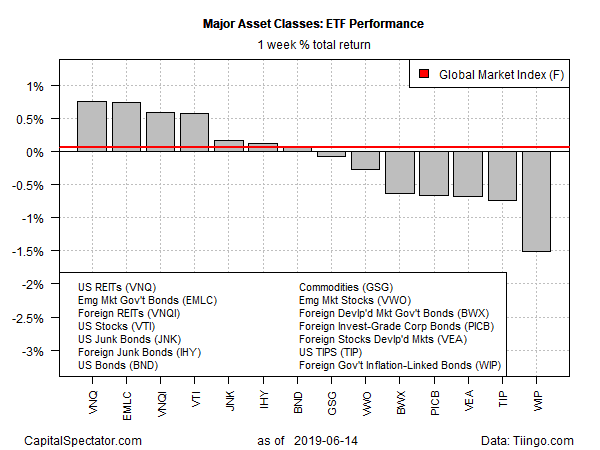US REITs Led Gains For Major Asset Classes Last Week
Securitized real estate shares in the US led a partial rally in global markets last week. Real estate investment trusts (REITs) posted a fractionally higher return over the second-best performer: bonds in emerging markets. Overall, returns for the trading week ended Friday, June 14, were mixed for the major asset classes, based on a set of exchange-traded funds.
Vanguard Real Estate (VNQ) closed at a new record high at last week’s close. Upside momentum has lifted the ETF in eight of the past ten calendar weeks.
The prospect of flat or falling interesting rates has fueled interest in REITs, which tend to offer relatively high yields. VNQ’s trailing one-year yield is just a few basis points below 4%, according to Morningstar.com. That’s nearly twice the level of the benchmark 10-year Treasury’s 2.09% current yield via Treasury.gov.
The Federal Reserve this week is expected to leave its target rate unchanged at a 2.25%-to-2.50% range in Wednesday’s policy announcement. Fed funds futures, however, are pricing in an 83% probability of a rate cut at the July FOMC meeting, according to CME data.
Last week’s second-best performer among the major asset classes: emerging-market debt. VanEck Vectors J.P. Morgan EM Local Currency Bond ETF (EMLC) gained 0.75% last week, posting its fourth straight weekly advance.
Half of the major asset classes posted losses last week. The biggest setback: foreign inflation-indexed government bonds. SPDR FTSE International Government Inflation-Protected Bond (WIP) shed a hefty 1.5%.
An ETF-based version of the Global Market Index (GMI.F), an unmanaged benchmark that holds all the major asset classes (except cash) in market-value weights, rose fractionally last week.

For the one-year trend, US REITs continue to hold the lead by a wide margin. VNQ’s total return for the past 12 months at last week’s close: a strong 17.4%.
The second-best performer for the trailing one-year period is a distant 7.5% total return for a broad set of investment-grade US bonds via Vanguard Total Bond Market (BND).
The deepest one-year loss for the major asset classes: broadly defined commodities. The iShares S&P GSCI Commodity Indexed Trust (GSG) has lost 14.6% over the past 12 months (252 trading days).
Meanwhile, GMI.F is up a modest 2.3% for the trailing one-year period.

Profiling the major asset classes in terms of price momentum shows that the across-the-board upside bias has recently cracked, although most ETFs listed above continue to enjoy a bullish tailwind. The analysis is based on two sets of moving averages. The first compares the 10-day moving average with its 100-day counterpart — a proxy for short-term trending behavior (red line in chart below). A second set of moving averages (50 and 200 days) offers an intermediate measure of the trend (blue line). As of last week’s close, a majority of funds are posting a bullish profile.

Disclosure: None.



